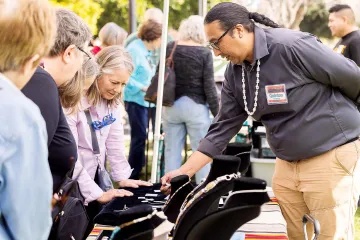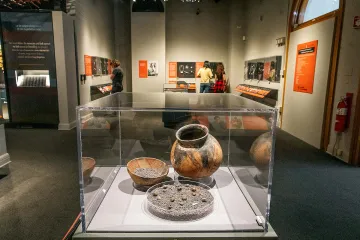Told in Turquoise
A new exhibit explores the works of Southwest Indigenous jewelry artists.

Ancient and modern jewelry pictured: Hohokam beads, c. 950-1150 and Kewa (Santo Domingo) beads by Joseph Pacheco, 1998. Mogollon turquoise mosaic, c. 1200-1400 and Kewa (Santo Domingo) turquoise mosaic by Mary Lovato, 2020.
Max Minj, 2022
Display cases of alluring silver, turquoise and shell necklaces make up part of the ancient, historic and contemporary jewelry crafted by regional Indigenous artisans in the Arizona State Museum’s newest exhibit, “Ancient – Modern: Continuity and Innovation in Southwest Native Jewelry.”

Visitors check out the exhibit on opening day.
Chris Richards
Open until February 2024, the exhibit also features intricate mosaic jewelry, along with silver bracelets, belt buckles, pendants and rings. It explores the deep cultural significance behind the use of specific materials, like turquoise and silver, and other Indigenous values and traditions the jewelry represents.
“We didn’t want to speak for Native artists; so, we incorporated jewelry makers’ own voices to express the values that come from their individual and cultural roots. This was especially important when it comes to turquoise and shell that have been used for millennia,” says Diane Dittemore, the museum’s associate curator of ethnology. “Through their work, they honor elements of nature. There are gender associations related to the colors of the stones — and to some shells, which originate from trade sources going back thousands of years.”
One highlight of the exhibit is a necklace of turquoise discovered in 1965 by a Tucson girl, Tani Bahti, while she picnicked with her family in the Santa Rita Mountains. Dating to circa 950-1150, the beads are seen as stellar examples of Hohokam artisanship.
Dittemore notes that this exhibit tells stories that have “a deep resonance with members of the Tucson community who know about the history behind some of these pieces we display. For example, we showcase a pot and its contents discovered by rancher Rey Romo in November 1949 while hunting on the west side of the Santa Catalina Mountains north of Tucson.”

Chris Richards
It is a red-on-brown earthenware jar, with a cover that contained approximately 90,000 stone beads and over two dozen spheroidal copper bells, each equipped with a ring eyelet for suspension. Such bells were traded into the area from western Mexico.
The exhibit also features prize-winning jewelry purchased from artists who participated in the museum’s former Southwest Indian Art Fair and works made by students who participated in the Southwestern Indian Art Project, a Rockefeller Foundation-funded program at the University of Arizona between 1960 and 1962 that introduced promising young Native American students to contemporary art concepts, with Native faculty including famous Hopi artist Charles Loloma.
“We are thrilled to be able to showcase the work of these artists from 60 years ago,” Dittemore says, “along with works from some of the best contemporary jewelry artists.”
